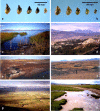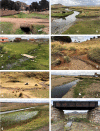Genetic uniformity, geographical spread and anthropogenic habitat modifications of lymnaeid vectors found in a One Health initiative in the highest human fascioliasis hyperendemic of the Bolivian Altiplano
- PMID: 32252808
- PMCID: PMC7137187
- DOI: 10.1186/s13071-020-04045-x
Genetic uniformity, geographical spread and anthropogenic habitat modifications of lymnaeid vectors found in a One Health initiative in the highest human fascioliasis hyperendemic of the Bolivian Altiplano
Abstract
Background: Fascioliasis is a snail-borne zoonotic trematodiasis emerging due to climate changes, anthropogenic environment modifications, and livestock movements. Many areas where Fasciola hepatica is endemic in humans have been described in Latin America altitude areas. Highest prevalences and intensities were reported from four provinces of the northern Bolivian Altiplano, where preventive chemotherapy is ongoing. New strategies are now incorporated to decrease infection/re-infection risk, assessment of human infection sources to enable efficient prevention measures, and additionally a One Health initiative in a selected zone. Subsequent extension of these pilot interventions to the remaining Altiplano is key.
Methods: To verify reproducibility throughout, 133 specimens from 25 lymnaeid populations representative of the whole Altiplano, and 11 used for population dynamics studies, were analyzed by rDNA ITS2 and ITS1 and mtDNA cox1 and 16S sequencing to assess their classification, variability and geographical spread.
Results: Lymnaeid populations proved to belong to a monomorphic group, Galba truncatula. Only a single cox1 mutation was found in a local population. Two cox1 haplotypes were new. Comparisons of transmission foci data from the 1990's with those of 2018 demonstrated an endemic area expansion. Altitudinal, northward and southward expansions suggest movements of livestock transporting G. truncatula snails, with increasing temperatures transforming previously unsuitable habitats into suitable transmission areas. Transmission foci appear to be stable when compared to past field observations, except for those modified by human activities, including construction of new roads or control measures undertaken in relation to fascioliasis.
Conclusions: For a One Health initiative, the control of only one Fasciola species and snail vector species simplifies efforts because of the lower transmission complexity. Vector monomorphism suggests uniformity of vector population responses after control measure implementation. Hyperendemic area outer boundary instability suggests a climate change impact. All populations outside previously known boundaries were close to villages, human dwellings and/or schools, and should therefore be considered during disease control planning. The remarkable southward expansion implies that a fifth province, Aroma, should now be included within preventive chemotherapy programmes. This study highlights the need for lymnaeid molecular identification, transmission foci stability monitoring, and potential vector spread assessment.
Keywords: Galba truncatula; Geographical spread; Habitat modifications; Human fascioliasis; Lymnaeids; Northern Bolivian Altiplano; One Health; mtDNA; rDNA.
Conflict of interest statement
The authors declare that they have no competing interests.
Figures






Similar articles
-
DNA multigene characterization of Fasciola hepatica and Lymnaea neotropica and its fascioliasis transmission capacity in Uruguay, with historical correlation, human report review and infection risk analysis.PLoS Negl Trop Dis. 2017 Feb 3;11(2):e0005352. doi: 10.1371/journal.pntd.0005352. eCollection 2017 Feb. PLoS Negl Trop Dis. 2017. PMID: 28158188 Free PMC article.
-
Human fascioliasis endemic areas in Argentina: multigene characterisation of the lymnaeid vectors and climatic-environmental assessment of the transmission pattern.Parasit Vectors. 2016 May 27;9(1):306. doi: 10.1186/s13071-016-1589-z. Parasit Vectors. 2016. PMID: 27229862 Free PMC article.
-
Fasciola hepatica and lymnaeid snails occurring at very high altitude in South America.Parasitology. 2001;123 Suppl:S115-27. doi: 10.1017/s0031182001008034. Parasitology. 2001. PMID: 11769277
-
Chapter 2. Fasciola, lymnaeids and human fascioliasis, with a global overview on disease transmission, epidemiology, evolutionary genetics, molecular epidemiology and control.Adv Parasitol. 2009;69:41-146. doi: 10.1016/S0065-308X(09)69002-3. Adv Parasitol. 2009. PMID: 19622408 Review.
-
Reviewing lymnaeid vectors of fascioliasis by ribosomal DNA sequence analyses.J Helminthol. 2005 Sep;79(3):257-67. doi: 10.1079/joh2005297. J Helminthol. 2005. PMID: 16153320 Review.
Cited by
-
Helminth/Protozoan Coinfections in Chronic Fascioliasis Cases in Human Hyperendemic Areas: High Risk of Multiparasitism Linked to Transmission Aspects and Immunological, Environmental and Social Factors.Trop Med Infect Dis. 2025 Aug 11;10(8):224. doi: 10.3390/tropicalmed10080224. Trop Med Infect Dis. 2025. PMID: 40864127 Free PMC article.
-
One-health approach on the future application of snails: a focus on snail-transmitted parasitic diseases.Parasitol Res. 2023 Dec 12;123(1):28. doi: 10.1007/s00436-023-08021-z. Parasitol Res. 2023. PMID: 38082123 Free PMC article. Review.
-
Global warming induced spread of the highest human fascioliasis hyperendemic area.Parasit Vectors. 2024 Oct 21;17(1):434. doi: 10.1186/s13071-024-06514-z. Parasit Vectors. 2024. PMID: 39434158 Free PMC article.
-
Fasciola hepatica juveniles interact with the host fibrinolytic system as a potential early-stage invasion mechanism.PLoS Negl Trop Dis. 2023 Apr 21;17(4):e0010936. doi: 10.1371/journal.pntd.0010936. eCollection 2023 Apr. PLoS Negl Trop Dis. 2023. PMID: 37083884 Free PMC article.
-
Fascioliasis.Adv Exp Med Biol. 2024;1454:157-201. doi: 10.1007/978-3-031-60121-7_5. Adv Exp Med Biol. 2024. PMID: 39008266 No abstract available.
References
-
- Valero MA, Bargues MD, Khoubbane M, Artigas P, Quesada C, Berinde L, et al. Higher physiopathogenicity by Fasciola gigantica than by the genetically close F. hepatica: experimental long-term follow-up of biochemical markers. Trans Roy Soc Trop Med Hyg. 2016;110:55–66. doi: 10.1093/trstmh/trv110. - DOI - PubMed
MeSH terms
Substances
Grants and funding
- 2017/ACDE/001583/Agencia Española de Cooperación Internacional para el Desarrollo
- RLA5049/International Atomic Energy Agency
- PI16/00520/ISCIII-MINECO/FEDER, Madrid, Spain
- RD16/0027/0023/Ministerio de Sanidad, Servicios Sociales e Igualdad
- 2016/099/Conselleria d'Educació, Investigació, Cultura i Esport
LinkOut - more resources
Full Text Sources
Research Materials
Miscellaneous

